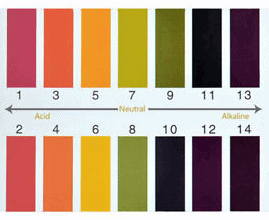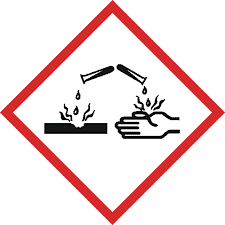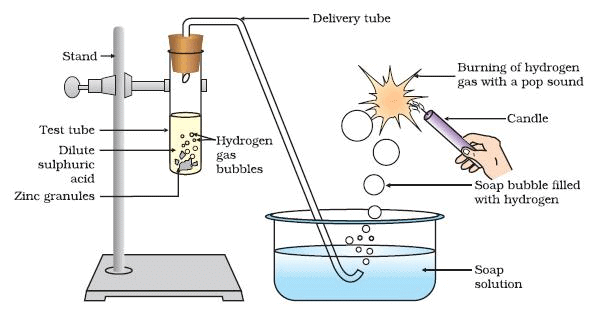Physical and Chemical Properties of Acids - Class 10 PDF Download
Properties of Acid and Bases -
(1) Physical properties of Acid -
(i) Taste - Acids have sour test.
(ii) Physical state Some acid are solids while other are liquid at room temperature.
Example
Solid - Oxalic acid (COOH)2, Boric acid (H3BO3)
Liquid - Acetic acid (CH3COOH), Formic acid (HCOOH), Sulphuric acid (H2SO4)
Volatile liquid Carbonic acid (H2CO3), Hydrochloric acid (HCl) , Nitric acid (HNO3)
(iii) Effect of Indicator
 Fig: Litmus paper is used as indicator They affect the indicators as given below
Fig: Litmus paper is used as indicator They affect the indicators as given below
Indicator Change in acidic medium
| Indicator | Change in acidic medium |
| Blue Litmus Paper | Blue to Red |
| Methyl Orange | Orange to pink |
| Phenolphthalein | Remains colourless |
| Turmeric paper | Remains Colourless |
Carbonic acid (H2CO3) turns blue litmus to pink. Because this is weak mineral acid.
Litmus A water soluble purple dye, extracted from certain lichens, a plant belonging to the division thallophyta and is commonly used as an indicator. The pH range for litmus is 4.5 - 8.3 at room temperature.
Ques: You have been provided with three test tubes. One of them contains distilled water and the other two contain an acidic solution and basic solution, respectively. If you are given red litmus paper, how will you identify the contents of each test tube?
Activity : Take small amount of finely chopped onions along with some strips of clean cloth in a plastic bag. Tie up the bag tightly and leave it as such in a refrigerator for a night. In the morning, take two of these strips and check their odour. Now put a few drops of dilute HCl solution on one strip and a few drops of dilute NaOH solution on the other. Rinse both the cloth strips with water and again check their odour and note down in your note book. You will see that onion will give different odour in HCl and NaOH.
You can repeat the activity by taking dilute vanilla essence. Smell dilute vanilla essence. Now take some dilute HCl solution in one test tube and dilute NaOH solution in another test tube add a few drops of dilute vanilla essence to both the test tubes and shake well. Check the odour once again. You will feel different smells in both the test tubes.Lastly, you can repeat the activity by taking clove oil in place of vanilla essence.From this activity, we conclude that vanilla, onion or clove oil can also be used as olfactory indicators since these change their odour in acidic and basic media.
(IV) Effect on Skin All strong mineral acids have a corrosive action on skin and cause painful burns. Fig: Acids have harmful effects on skinExample Concentrated sulphuric acid stains the skin black.
Fig: Acids have harmful effects on skinExample Concentrated sulphuric acid stains the skin black.
Concentrated nitric acid & hydrochloric acid stains the skin yellow.
(V) Electrical Conductivity All mineral acids are good conductors of electricity and conduct electricity in their aqueous solution. On electrolysis, they decompose liberating hydrogen at cathode.
(2) Chemical Properties of Acids
(I) Reaction with metals
Dilute acids like hydrochloric acid (HCl), sulphuric acid (H2SO4) react with certain active metals to evolve hydrogen gas and form their metallic salt
Activity: To study the reaction of acids, with metals.
Materials required: Granulated zinc, Dilute sulphuric acid, Boiling tube, Matchbox
Procedure: Take about 5 ml of dilute sulphuric acid in a boiling tube. Add a few piece of zinc metal into it and place an inverted boiling tube over its mouth . Your can see the bubbles of hydrogen gas coming out of the mixture in the lower tube. After a few minutes, remove the upper boiling tube (Keeping its mouth downwards) near to its mouth. What do you see ? The gas in the upper boiling tube burns with a blue flame producing popping sound. Repeat similar experiment with different acids and a few other metals. Write down your observations.
 Observation: Colourless, odourless gas is evolved. It burns explosively with a 'pop' sound.
Observation: Colourless, odourless gas is evolved. It burns explosively with a 'pop' sound.
Zn(s) + H2SO4 (dil) → ZnSO4 (aq) + H2(g)
Conclusion: Reactive metals react with dilute acid to liberate hydrogen gas. Metals which can displace hydrogen from dilute acid are known as active metals. e.g. Na, K, Zn, Fe, Ca, Mg etc.
(II) Reaction with metal carbonates and metal Hydrogen Carbonates
Both metal carbonates and hydrogen carbonates (bicarbonates) react with dilute acids to evolve CO2 gas and form salt.
Activity: To study the reaction of sodium carbonate and sodium hydrogen carbonate with dilute acids.
Materials required: Sodium carbonate (Na2CO3), Sodium hydrogencarbonate, Hydrochloric acid (dil.), Limewater, Boiling tubes, Delivery tube.
Procedure: Take about 0.5g of sodium carbonate in a boiling tube, and 2-3 mL of freshly prepared limewater in another test tube. Set a delivery tube as shown in fig. given alongside. Add about 2mL of dilute hydrochloric acid into the boiling tube containing sodium carbonate. A brisk effervescence is seen in the reaction mixture. Pass the gas evolved through limewater with the help of a delivery tube. What do your observe ? The limewater turns milky. When excess of carbon dioxide is passed, the milkyness disappears. Repeat similar experiment with sodium hydrogencarbonate (NaHCO3), and if desired with other acids also.
Conclusion: All acids decompose carbonates and hydrogencarbonates with the liberation of carbon dioxide gas.
(i)
(ii)
(iii)
(iv)
(v)
(III) Reaction with metallic oxide
Metal oxides react with dilute acids to form salt and water.
Activity: To study the reaction of dilute acid with metal oxides (or basic oxides.)
Materials required: Copper (II) oxide, Dilute hydrochloric acid , Test tube
Procedure: Take about 0.5g of copper (II) oxide (black in colour) in a test tube. Add dilute hydrochloric acid drop wise with occasional shaking till copper (II) oxide dissolve. Note the colour of the solution. I not it bluish-green ? It is the solution of copper (II) chloride.
Conclusion: Acids react with metal oxides to give the corresponding salt & water.
(IV) Reaction with metallic sulphites and hydrogen sulphites
Metallic sulphites and hydrogen sulphites react with dilute acids to liberate sulphur dioxide.
(i)
(ii)
(V) Reaction with metallic sulphides and hydrogen sulphides
Metallic sulphides and hydrogen sulphides react with dilute acid to liberate hydrogen sulphide gas.
(VI) Reaction with metal chlorides
Metal chlorides react with concentrated acids to produce hydrogen chloride gas. Which give white dense fumes with ammonia.
(i)
(ii)
(VII) Reaction with metal nitrates
Metal nitrate react with concentrated acids to produce more volatile nitric acid.
(VIII) Reaction of Acid and Base with each other
All metallic hydroxides (Bases) react with acids to form their metallic salt and water. This reaction is also known as acid-base neutralisation reaction.
Activity: To study a reaction of an acid say, hydrochloric acid with an alkali or base.
Materials required: Hydrochloric acid solution, sodium hydroxide solution, phenolphthalein indicator, Boiling tube, dropper, trough.
Procedure: Take about 5 mL of dilute solution of sodium hydroxide (NaOH) in a test tube. Add 2 drops of phenolphthalein indicator in it. The solution in the test tube turns pink. Now, add dilute solution of hydrochloric acid (HCl) when the pink colour of the solution just disappears.
Now, add a drop of sodium hydroxide solution and shake the test tube to mix the solution. What do you see? The solution turns pink. Add a drop of HCl solution to the solution in the test tube. The pink colour disappears. Keep repeating the addition of sodium hydroxide and hydrochloric acid solution one after the other and watch the appearance and disappearance of pink colour.
Conclusion: This experiment show that the addition of HCl solution destroys the alkaline nature of NaOH. On the other hand , the addition of NaOH solution destroys the acidic nature of HCl. That is, both NaOH and HCl appear to cancel the effect of each other. Such a reaction between an acid and alkali is called neutralisation.
Ques: What is a neutralisation reaction ? Give two examples.
(i)
(ii)
(iii)
(iv)
(v)
FAQs on Physical and Chemical Properties of Acids - Class 10
| 1. What are some physical properties of acids? |  |
| 2. What are some chemical properties of acids? |  |
| 3. How do acids affect pH? |  |
| 4. What are some common acids found in everyday life? |  |
| 5. How are acids used in industry? |  |




















